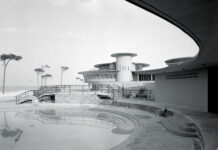
The Blue College occupied this handsome Greek revival structure on Government Street. A blue paint job earned it that nickname. Courtesy Windsor Collection, The Doy Leale McCall Rare Book and Manuscript Library, University of South Alabama
The Blue College, also known as Mr. Pinney’s Collegiate Institute, was founded in 1852 by Norman Pinney as a boy’s prep school. Pinney, a native of Simsbury, Connecticut, and an 1823 graduate of Yale, had originally studied to become an Episcopal minister. After briefly serving as a professor of ancient languages at Hartford’s Trinity College, he accepted a call to Mobile to serve as an Episcopal minister in 1831.
It is unclear how long he served what ultimately became Christ Episcopal Church, but his decision to become a Unitarian ended that career. The Unitarians were staunch abolitionists and faced an uphill battle in most southern cities, including Mobile.
In 1839, Mr. Pinney attempted unsuccessfully to establish a college in Mobile before starting a private school in 1845, which he called The Mobile Institute offering “Ancient and Modern Languages: French, Spanish and German.” He offered “Collegiate Studies and Modern Language” at a tuition of $12 per month. It was located on the northwest corner of St. Joseph and St. Michael streets.
A College Prep School
It was in 1852 that Barton Academy became a true public school. Perhaps the fact that it had not developed a track record for getting its graduates into prestigious colleges led to the success of Pinney’s school.
Mr. Pinney’s record as a scholar and a linguist as well as being the author of popular textbooks in both French and Spanish, drew students and wealthy supporters. Sidney Smith, first president of the Mobile and Ohio Railroad, led the financing of a new school building for Pinney in the early 1850s.
The Greek revival structure stood on the south side of Government Street about where South Georgia Avenue is today. It was set well back from the street and a smaller structure to the east was Mr. Pinney’s residence. Although originally known as Collegiate Institute, the building’s unusual blue paint scheme earned it the more popular name of the Blue College.
Physically, Pinney was described as having been of medium height with a slender build and a “very long nose.” His students were to speak only French during school hours.
The last advertisement for what he then termed Mobile College was in the summer of 1861. Annual tuition for boarders was set at $300 for a “scholastic term of nine months.” A $50 discount was given “for students who spend their Saturdays and Sundays at home.” Tuition included “all expenses except room furniture and books.”
Pinney Departs
Alabama had seceded from the Union in January of that year and it is unclear whether Mr. Pinney attracted many boarders as men began joining Confederate companies that were quickly forming. Mr. Pinney did not stick around.
In the September 14, 1862, issue of the Times-Picayune an advertisement appeared describing a “New Institution on Calliope Street. The Mess’rs Pinney and Saunders Cheerfully Request the Patronage of the Public.”
New Orleans had surrendered in April of 1862. Somehow, Pinney traveled though enemy lines to get there and decided that under the new regime there would be a place for his prep school. Fate got in the way however and records indicate that he died on October 21, 1862, a month after announcing his new school. Just where this talented scholar was buried is a mystery.
Pinney’s name resurfaced in Mobile Probate Court records in 1863 when a judge ordered the sale of his property to settle his estate. His inventory consisted of “a large quantity of books” and there were outstanding debts for his building, teachers’ salaries and a bill for books from J. K. Randall Booksellers in Mobile.
It is unclear what happened to the structure housing Pinney’s school between the date of his departure and the end of the war, but in November of 1867 there were entries in probate court records indicating Pinney’s estate was finally settled.
Emerson Institute
The American Missionary Society purchased it as the largest of 10 grammar schools set up for the education of the children of emancipated slaves in Mobile. This abolitionist group was founded in upstate New York in 1846. After the Civil War their focus was on education, establishing both grammar schools and colleges for the training of teachers. They actively recruited teachers in the North and found them housing in southern cities.
The former Blue College became Emerson Institute and had 300 pupils. The school’s principal, Edward Parson Lord, occupied Mr. Pinney’s former home to the east. Lord, a Connecticut native, was an 1868 graduate of Michigan’s Olivet College, known for its strong abolitionist position.
Emerson Institute operated at this site until a fire in April of 1876 reduced it to ashes. The fire was thought to have originated on the first floor and as reported in the Mobile Register, “there was a strong north wind blowing at the time and soon the whole building was wrapped in a livid sheet of flame. We were unable to learn the origin of the fire.”
It would be decades before the city had a water system with fire hydrants and the only water available came from the cisterns of two neighboring homes. According to the newspaper account, “The neighbors kindly offered to accommodate the (teachers) but they gratefully declined and went to the Gulf City Hotel.”
The following year, Emerson Institute moved to a site at 266 Scott Street where it would operate for 50 years. In 1927, it became part of the public school system.
Eventually the Government Street lot was cleared of the ruins and in 1883 a grand mansion was constructed on the property. The southern portion of the large lot became an extension of South Georgia Avenue.
Mobile would not have another college preparatory school until the establishment of University Military School by Julius T. Wright in 1893.





